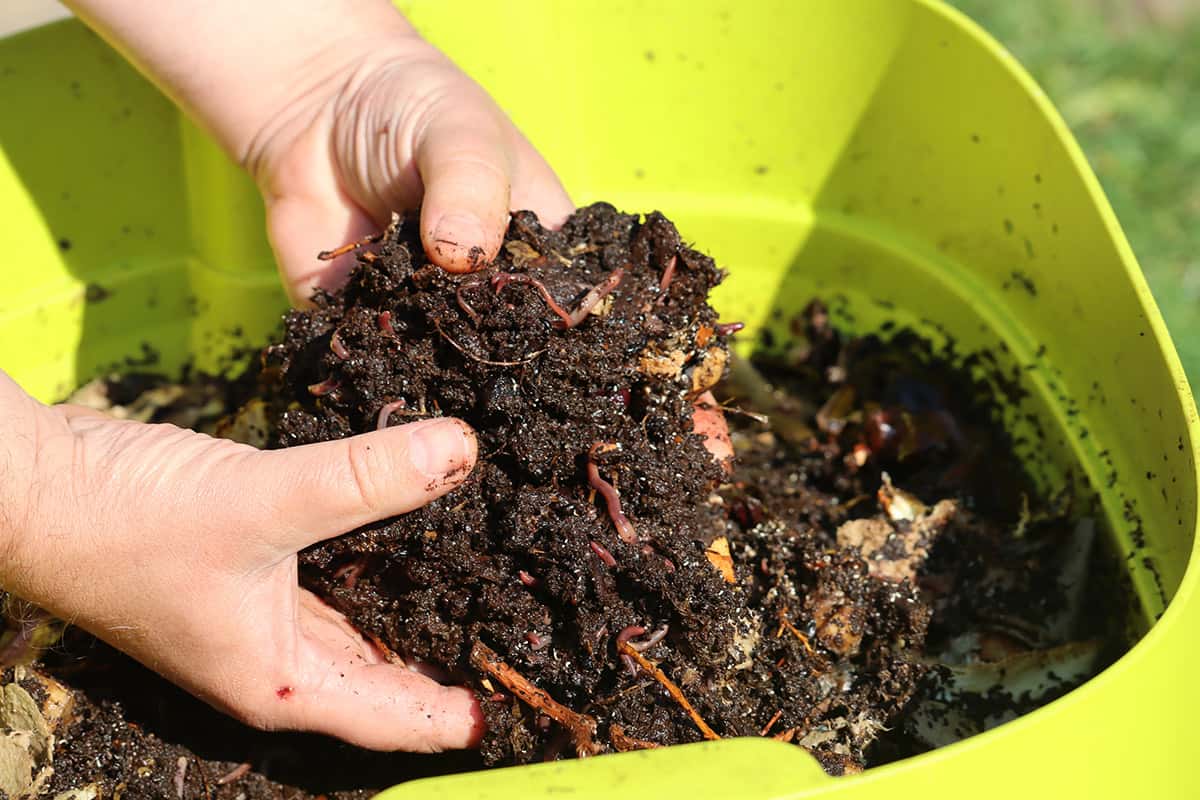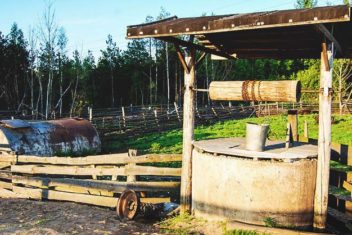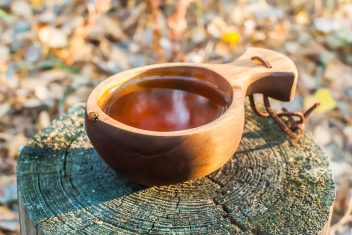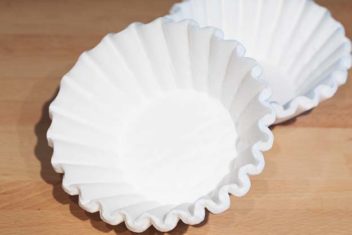Ever heard of worm farming? This compost production method is also known as vermicomposting or vermiculture, and it’s extremely popular with homesteaders because it makes for fabulous soil. Not only that, but all that worm poop is black gold. It’s extremely good for your garden and people are willing to pay for it.
Let’s dive into this fascinating topic so you can see why it’s beneficial to both your garden and livelihood.
What is Worm Farming, Exactly?
In simplest terms, a worm farm is a bin of some sort in which earthworm friends transform food and household scraps into compost. These can be small and simple enough to fit beneath your kitchen sink or elaborate, multi-stacked worm condos outdoors.
Basically, worm farming is just employing these wormy friends to break down matter into soil. You’ll then use this soil to grow spectacularly healthy vegetables, fruits, and herbs. You can use these low-maintenance farms to supply your own garden or you can expand your operation and sell the marvelous compost.
What are the Benefits?

Worm composting is good for the planet, your garden, and your wallet. Worm poo, also called worm casting, is a fantastic, nutrient-rich, and organic addition to your garden soil.
First and foremost, the resulting product will help you have amazing soil health. The castings that the worms create (i.e. their fecal matter) are often referred to as “black gold”. This is because the castings are incredibly nutrient-dense, and can help to replenish even the most depleted soil.
Your plants will appreciate the tunnels made by the worms as their roots can reach extra moisture and goodness deeper in the soil.
Additionally, vermicomposting speeds up the composting process significantly. Most kitchen scraps end up in standard compost heaps, where they break down over several months. With the help of little worm friends, however, that process is accelerated.
When items are processed through the worms’ guts, that process removes harmful pathogens and promotes beneficial bacteria. As a result, everything is broken down into elements that are more easily absorbed by plants.
In some parts of the world, large-scale worm composting is being used to dispose of waste material from sewage plants. This turns harmful, potentially toxic human waste into organic fertilizer with enhanced nutritional value and no harmful pathogens.
In poorer countries, worm farming is promoted as an effective way to raise the fertility levels in the soil. There is often plenty of labor available, but little in the way of resources to buy materials. Organic material is always available, whether it is animal dung, paper, leaves, or grass.
As another bonus, having a worm farm decreases individual trash creation. After all, why throw items into a landfill when they can be processed into healthy soil?
Steps to Build a Worm Farm
You can make your worm farm as small or as big as you like, depending on the amount of space and food supply available to you. You can start small and, over time, you can extend it.
Some people up worm farms using nothing more than stacked used tires stacking, while others have sophisticated systems that produce gallons of black gold. The level of sophistication is all up to you.
Vermicomposting Glossary: Get to Know Some Common Terms
Before we dive into the details, let’s make a note of some essential worm farming terms. This way, you’ll know what we’re talking about when we get into details further on.
- Anaerobic vermicompost: when compost is anaerobic, it means that there isn’t enough oxygen getting into it. It’ll smell terrible and be dark and compacted. Additionally, your worms will be clinging to the inner sides, trying to get away from the soil.
- Bedding: this makes up the majority of your worm bed contents. It’s going to be carbon-rich, so you’re looking for shredded paper, untreated cardboard (like egg cartons), dry leaves, etc. You can also add coconut coir, peat moss, and straw.
- Castings (aka worm castings or vermicastings): worm poop. This is the “black gold” that worms create by digesting organic matter.
- Continuous Flow Through (CFT): this describes how worms work their way upwards through layers of matter. They leave behind their castings and leachate (see below).
- Leachate: this is the liquid that will collect in the bottom-most tier of your worm bin. It’s the water that gets released from the cells of decomposing (digested) food scraps. This is the super nutrient-rich stuff you’ll want to dilute with water and use as compost tea in your garden.
So how do you start a worm farm? Let’s dig in.
1. Location, Location, Location
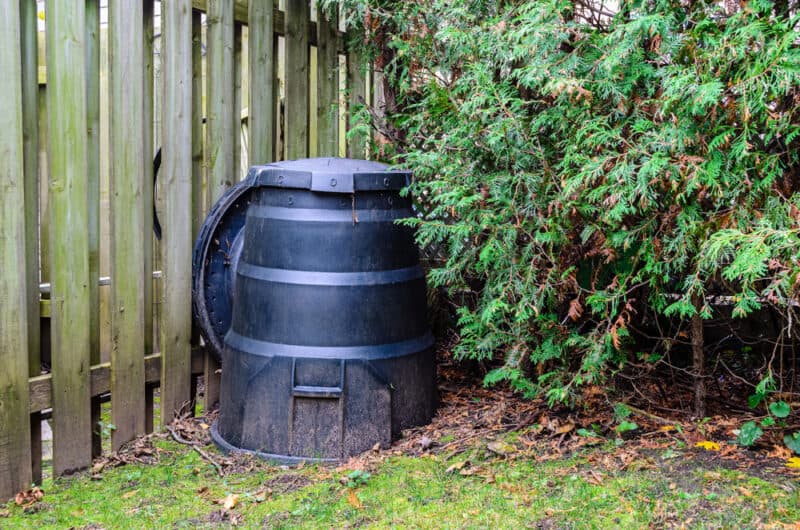
Location is vital when raising worms. Worms like constant temperature. If you own your home or if your landlord is cool with it, then try to keep your worm farm indoors. A constant temperature of around 55-75°F is ideal, but they can handle slight variations between 40-80°F.
If their surrounding temperature drops below 50°F, they’ll go into a sort of torpor and won’t digest anything. Furthermore, if it drops below 40°F, your worms will die. Similarly, temperatures above 80°F will have your worms clamoring to get deeper, away from the heat. If heat rises above 90°F, your worms will cook and die.
A kitchen cupboard or under the sink is convenient for tossing your fruit and vegetable scraps. If your kitchen isn’t suitable or big enough, a basement is also fine.
Outdoor worm bins also work if you live in a temperate climate that doesn’t get extreme temperature variations. Although worms are quite hardy, remember that high or low temperatures will slow, sicken, and eventually kill them.
Provide insulation during the winter, and cool respite in the summer. Keep the bins out of direct sunlight and sheltered from the rain. Although you need their bedding to be damp, it shouldn’t be soaked. You will also have to cover them to protect them from birds and bats – you don’t want them to come and steal your worms.
2. A Home Fit for a …. Worm
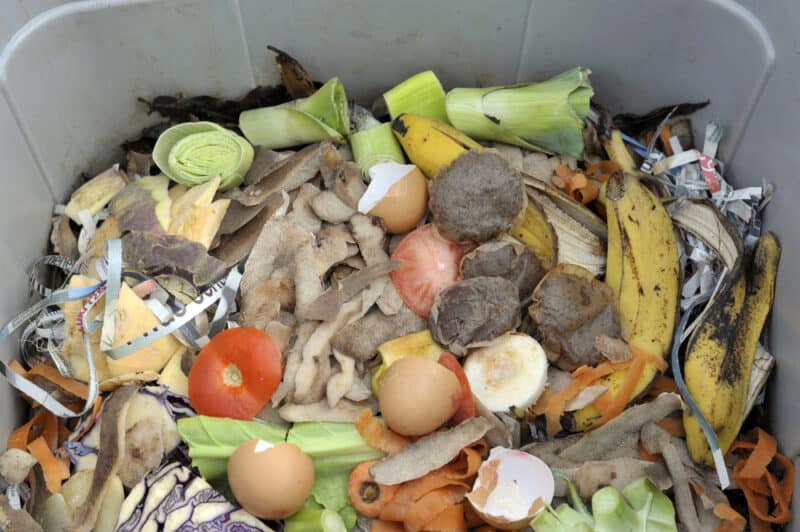
There are many options to start your worm farm. I divided my two pounds of worms equally into two 30-gallon bins, and there’s plenty of room for them to squidge around, munching and breeding merrily. You can make your own out of plastic or wooden containers, or buy a pre-made bin.
A pre-made compost bin is a quick, convenient and easy way to start turning your food scraps into compost. However, pre-made worm bins may not be the right size or shape for your situation, and they can be expensive.
To make your own system, get hold of two 5-gallon plastic tubs, one lidded and one without. They shouldn’t be transparent as worms are happier in the dark. They need to be at least 12-inches deep.
Wash them well and drill a series of small holes around the sides at the top and about 20 1/4-inch holes in the bottom sides of one of the bins. Leave the other bin with no holes. On the lid, drill at least ten 1/4-inch holes to provide some airflow. Then place a brick or small flower pot upside down in the tub with no holes.
Put the bucket you have drilled on top of the brick. That way the liquid that accumulates will drain away into the undrilled bin below. This liquid can be harvested as worm tea, which makes your excellent fertilizer. Also, it prevents the worms from drowning when the liquid builds up.
Another option is to use stackable plastic bins in the same way. Not the transparent kinds, as they’re likely to bake your worms instead of protecting them. Worms like darkness.
Large bins allow at least 2 inches of empty space at the bottom, which is perfect for allowing leachate to drip through.
Just drill several 1/8-inch holes into the bottom of one bin. Aim for at least 20 of these holes, evenly spaced across the bottom. Then place that bin into the other, un-drilled one. You can place a couple of bricks in that bottom crate for extra height if you want to. You’ll also need to drill some holes into the top lid as well so your worms don’t suffocate.
With either method, add bedding, worms, and organic matter into the top bin to be transformed into compost. The lower bin will collect liquid, and can be emptied out easily as necessary.
3. Give Them Cozy Bedding
When creating worm bedding, you’re basically adding the items that will be transformed into compost. You can use items like shredded newspaper, torn-up cardboard, leaves, other vegetables, and just a couple of scoops of soil. Keep away from glossy color printed paper or cardboard. And if you add dried leaves, avoid any that contain a lot of oil or have a strong scent.
Worms need the soil to process their food in the same way that chickens need grit. Add just enough water to moisten it, but it should not be wet. Worms can drown if there’s too much moisture in their bedding.
Some people add wood shavings to their worm bins, but most vermicompost aficionados advise against it. This is because wood that isn’t 100% organic can poison your worms, and contaminate your soil. If you have shavings left over from cutting down trees or whittling wood harvested from your own property, that should be fine. Just don’t toss off-cuts from construction projects or revamped furniture in there.
Fill the bin 3/4 with bedding, and make sure to fluff it regularly. This will allow air to circulate properly.
4. Choose Your Worms with Care
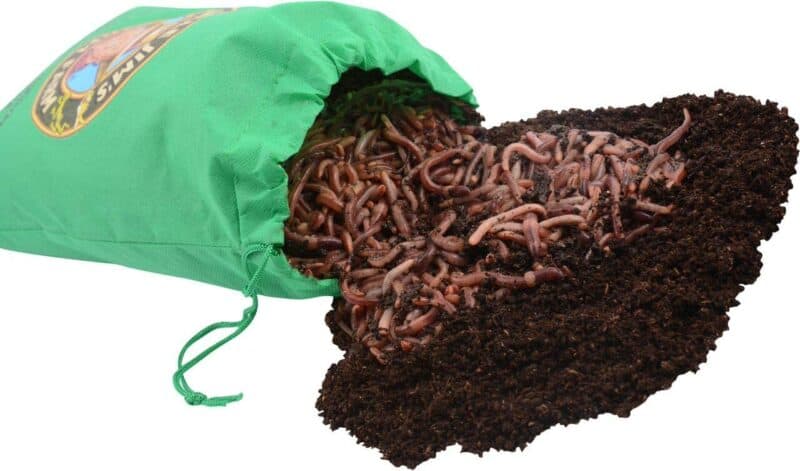
Since this is a worm farm, you’ll need some of the aforementioned wormy friends to put into it. There are several different species of worms to choose from. The most popular are red wigglers (Eisenia Fetida) and redworms (Lumbricus rubellus). These small worms are ideal for any vermicomposting bin and reproduce quite enthusiastically.
You can also use European nightcrawlers (Eisenia hortensis), which are popular with people who use worms as bait for fish. If you plan on selling your worms, these might be a good option.
Make sure to get your worms from a reputable supplier so you know that the worms have been grown in a controlled, clean environment and are free from pests and disease. The worms should be clean, so you get the weight you order in worms rather than soil.
Are you trying to figure out how many worms you’ll need to raise, plus space needed and cost? Let’s break that down a bit (pun intended).
Usually, worms are sold by the pound and there are roughly 1000 in a pound. Assume that you need about one pound of worms for every two people living in your household. If you have two pounds of worms, they’ll need a fair bit of living space.
The recommended stocking density is 1 pound of worms for 4-square-feet of bin surface area.
Finally, when you have chosen your worms and are ready to add them to the container, make sure you add some moist newspaper over them. Then take a few more sheets of newspaper, roll them up and tuck these sheets around the corners. This will form a seal so that the worms are safe and protected. Don’t feed them for the first few days.
Incidentally, almost all earthworms aren’t native to North America, and they can have a negative impact on the native flora and fauna of forests, so don’t release your wigglers into the wild. Keep them in your garden.
How to Feed Your Worms

To feed your worms, just toss in your kitchen scraps! Ok, there’s a bit more to it than that, but it’s pretty simple. You need to feed a mix of canon and nitrogen-based things, just as you do regular compost.
You’ll be able to see if you’ve got a good mix just by looking in the bin – you’re aiming for a good ratio of carbon to nitrogen. Newspaper, empty loo roll cartons, cardboard egg boxes or trays, leaf litter, and eggshells – all great food for your worms. Just take care not to use coated or colored paper.
If the worm farm’s temperature gets too high from the decomposing matter, it can kill your worms. If you have produced garden compost before without the addition of worms, you will know that this heating-up process is necessary.
Not so in vermiculture. The worms are efficient at processing their food, and you can help them by chopping up their food into smaller pieces. They don’t need to heat to get it done.
You may also find on occasion that you have a surplus of high nitrogen matter, such as farmyard manure or grass clippings. It’s not a good idea to add too much of this to the worm bin at once because it contributes to overheating.
What Food Can You Use?
You can find a full list of things to feed (and not feed) your wormy friends in our Ultimate Guide to Worm Composting article. That said, we’ll touch upon some of the basics here as well.
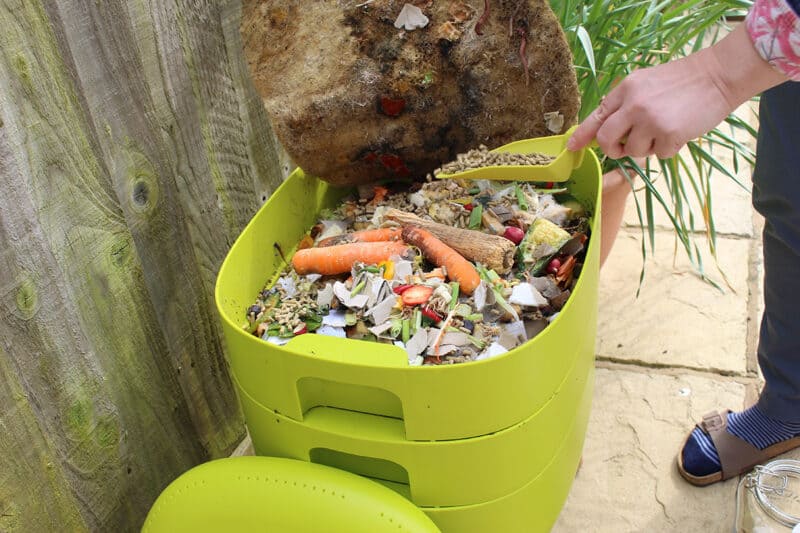
As mentioned earlier, it’s important to wait a couple of days before you give your worms any food scraps. Let them acclimatize to their new home first.
The first rule is to not overfeed your worms. Remember that they’re small, and if you give them too much they won’t be able to cope. They won’t multiply immediately, and you’ll end up with a stinking bin that’ll kill your worms and attract pests.
Aim for a 2:1 ratio of worms to food offered. So for every 2 pounds of worms, you need 1 pound of food. Some species can even eat up to their own weight in food in just a day, so it’s really just trial and error at first. See how much and how fast the food is disappearing.
The key to healthy worm food is variety, and chopping food bits into small pieces. Also, keep in mind that decomposition rates will vary depending on what type of food you’re offering. For example, vegetables like roots and brassicas will take much longer to break down than overripe fruit.
YES:
- Vegetable and fruit trimmings (potato and carrot peels, apple cores, etc.)
- Lettuce and other greens that have gone “off”
- Banana peels
- Coffee grinds
- Used tea leaves
- Eggshells
- Grass clippings
- Small amounts of shredded 100% natural cloth or fiber (cotton, wool, jute, bamboo, hemp, linen, silk, cashmere)
- Torn-up cardboard toilet paper or paper towel rolls, egg cartons, etc.
- Shredded newspaper (non-glossy or colored)
- Herbivore animal droppings (rabbit, goat, deer, guinea pigs, degus, etc.)
NO:
- Meat
- Dairy
- Cooking oils/grease
- Grains
- Carnivore pet droppings (dog, cat, ferret)
- Spicy food scraps
Many people suggest avoiding citrus peels as they’re too acidic, but others advise just keeping them to a minimum. Additionally, keep in mind that grass clippings and coffee grounds are rich in nitrogen, so they heat up quickly and help to turn the pile into a beautiful dark, rich soil. Consequently, you should only offer these in small quantities.
How Often to Feed Your Worms
In all honesty, this depends entirely on how quickly your worms will get through their food.
Some experts advise feeding a 3:1 ratio of food to worms weekly. This means that you’d offer 3 pounds of food to 1 pound of worms on a weekly basis. Others advise adding 1 cup of food into the bin every few days.
It’s always better to err on the side of under-feeding your worms, rather than over-feeding. This way, they have plenty of time to digest scraps before they rot into a sludgy mess. Always pour their food into one dedicated place in the bin. The worms will come to collect it, so you don’t have to worry about spreading it out.
Start by giving your worms a cup of food every 3-4 days. If you find that they tear through that completely, then increase the frequency to every 2 days. Alternatively, if they’re being sluggish with their feeding habits, decrease the amount of food and space out feedings a bit more.
For the first few weeks, the worms will be getting used to their new home. Don’t overfeed them and don’t expect a lot of castings.
A family of 4 should have plenty of food scraps for your worms so don’t worry about that either. However, if you find yourself with no available food, or you’re going away, just shred up some old newspaper. They’ll be fine with that for a day or two until you have more scraps to feed them. When you have too many scraps, just freeze them for later.
Plan for Eventual Expansion
Your worms will grow quickly, and you’ll undoubtedly need more room for them within a few months. When they’ve multiplied beyond the current bin, you have a few options.
Option 1: Transfer Everything Into a Larger Bin System
Get a bin system that’s about three times the size of your current worm farm. Prep it as you did before with air holes etc, and dump all the contents of your worm house into it.
Option 2: Create More than One Bin
Basically, try making a worm farm village instead of just one single house. You can even shove PVC pipes between them so your wormy friends can visit between locations.
Option 3: Donate or Sell Some Worms to Other People
You may be surprised to discover just how many people are eager to get their hands on healthy worms for a vermicomposting system. If you’re already part of an online homesteading or permaculture community (like Permies), then scan posts to see who’s searching for red wigglers. Alternatively, you can post on Craigslist, Kijiji, or social media.
Additionally, if you have friends or family members who like the idea of starting a worm farm, you can surprise them with a ready-made one. Just start a new bin system and establish it with bedding and wigglers. Then put a bow on it and surprise the recipient with a farm that just needs some potato peels and lettuce to keep it going.
If you love someone, give them worms.
Profit from Your Worm Farm
With low start-up and negligible running costs, it’s an easy business to get into. In less than 6 months, you can start to sell your products to gardeners and fishermen alike – plus of course, you will have your own amazing compost and fertilizer for the garden!
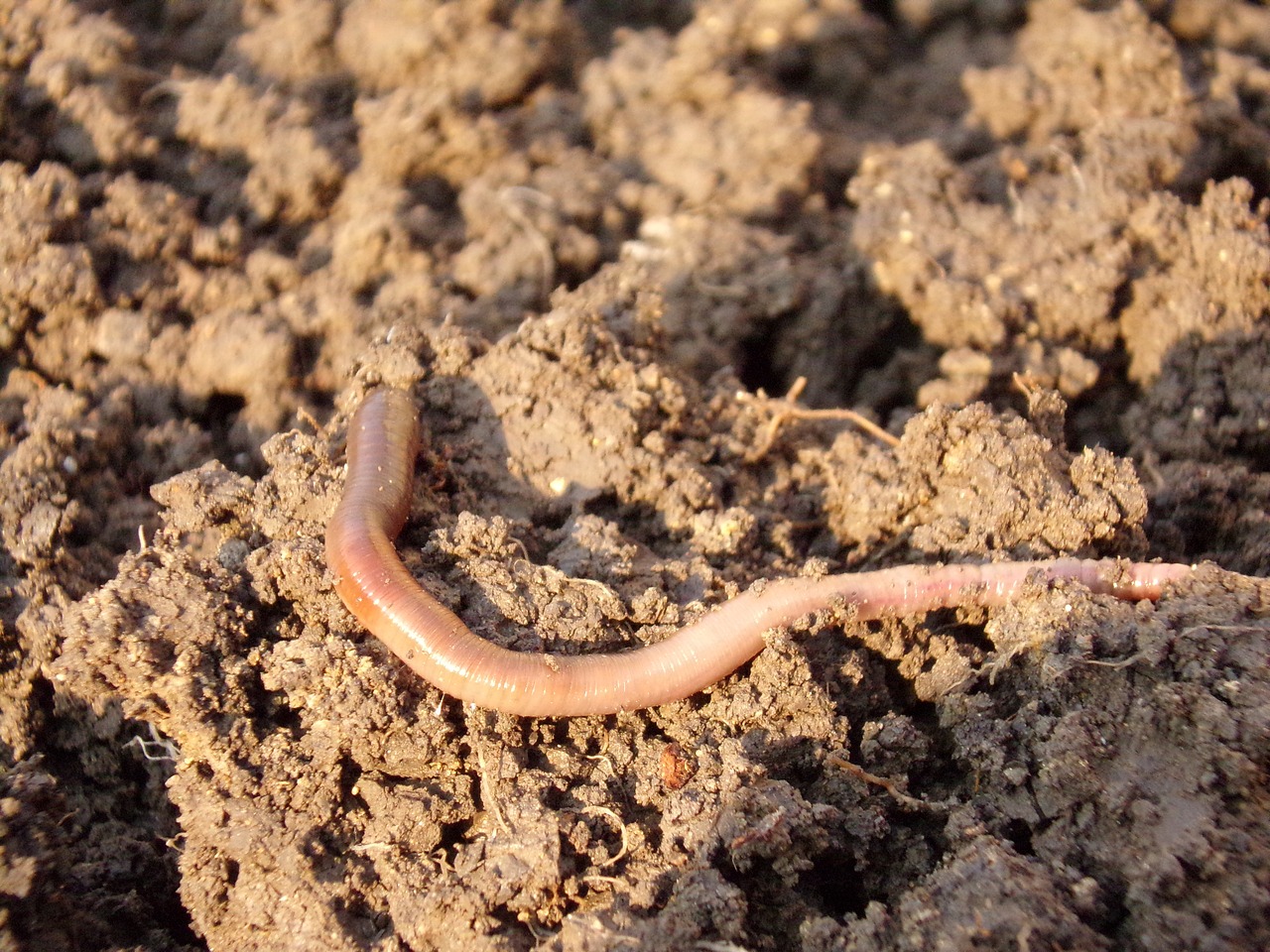
So now you have learned how to raise worms, how do you make money from this venture?
Thanks to sites like Craigslist, Facebook, and local yard sales web pages it’s easy to advertise that you have worms for sale. It gets even better if you are willing to ship your products to your customers. You can also advertise in local newspapers, set up a road sign, or set up a stand and sell them direct near a popular fishing spot.
If you have a green thumb, you can also raise seedlings and sell them and your worms at a local produce or farmer’s market. You will be surprised by how many people want worms to improve their garden soil. You can also sell compost that your worms have made once it looks like soil and is neither soggy nor smelly.
As you can tell, there are many ways to turn this small idea into a thriving business. You may not get rich from it, but it could become another source of revenue for your homestead.
FAQ: Maintenance and Troubleshooting
As mentioned in the article, there are a number of different issues that may affect your vermicompost bin system.
One of the best ways to ensure that your worms stay healthy and happy is to maintain a constant carbon:nitrogen ratio of 30:1 (or even higher carbon, if you want to keep things on the safe side). This means that you’ll put in 30 pieces of shredded paper or cardboard for every equally sized piece of lettuce.
You can always cover with a layer of wet newspaper if you find it is starting to dry out too quickly. Any excess liquid, known as worm tea or worm juice, should be drained off. This is a great organic fertilizer for your plants. If you start to find that you have a problem with worm losses, then you may need to add more protection to your bins.
You can use a sheet of mosquito netting and loosely cover your bins with this. This will eliminate most flying pests and doesn’t make the management of your worm bins any more difficult. If your worm farm is indoors, then make sure that doors and windows are fixed with mosquito screens or netting. This makes it harder for pests to gain entry in the first place.
Covering your food scraps is one of the best and most effective steps you can take regularly to ensure healthy worm bed management. This keeps the worm composting bin clean and reduces the likelihood of overactive pest infestations.
No Castings
If you aren’t getting any or many castings, it could mean that your worms aren’t getting enough food or they aren’t getting the right mixture of foods. Be careful to give them the right combination as described above and try adding more food.
A lack of castings could also be caused by temperatures that are too high or too low. If you are providing enough and the right mixture of food but the worms don’t seem to be eating it, check to see if they are experiencing temperatures that are too hot or too cold, causing them to go into a temperature torpor.
Stinking Worm Farm
If you find that your worm farm is starting to stink or looks sludgy inside, then there’s far too much nitrogen-rich plant matter. When this happens, your worms are basically drowning in their own filth and may try to escape the soil below.
The best way to amend this is to just start over.
Put on a pair of rubber or latex gloves, and root through the compost to save as many of your worms as you can. Pop them into a clean cup or bowl as you work. Once you’ve rescued as many as possible, dump the contents outside in your compost heap. Then wash every part of your bin system with an eco-friendly soap, and rinse it all very thoroughly.
Let this sit out in the sun until everything is completely dry. Then fill it with fresh bedding and a couple of spoonfuls of healthy soil. Sprinkle that with just a tiny bit of water to moisten it, and pop your worms back in. Let them settle in for a couple of days before adding in any new organic matter.
Sickly Worms
It’s important to check on your worms regularly to make sure they’re staying healthy. One of the most common afflictions they’ll suffer from is protein poisoning. This is also called “string of pearls” poisoning, and is quite troubling to see. If you want to look at an example, you can check out this image.
This is a type of severe food poisoning that occurs when the worms have too much protein added to their bins. When and if this happens, remove all undigested food bits immediately and scoop out any wet soil. Add in big handfuls of carbon (dry) bedding, and several clean, dry, crushed-up eggshells.
Not only do the shells provide grit for food digesting, their alkalinity and calcium content will counteract the acids from fermenting foods. This is sort of like taking a calcium digestive tablet like Tums or Rolaids when you have heartburn.
Flies
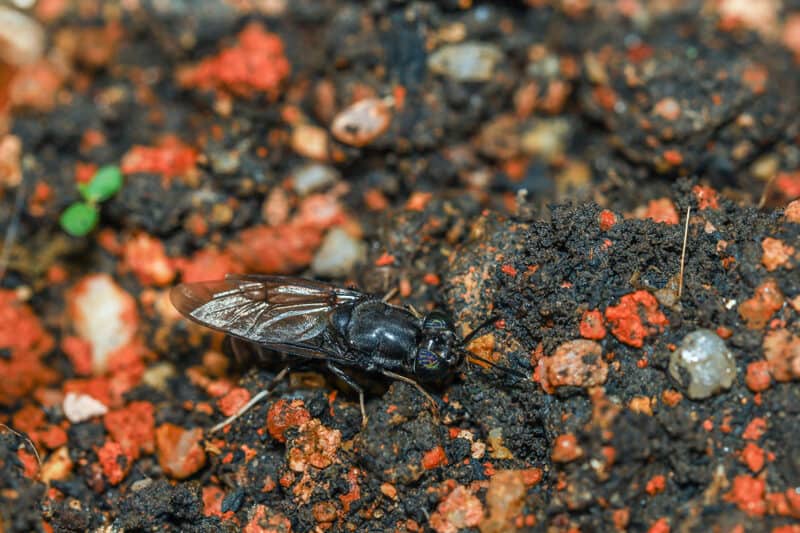
Composting matter will inevitably draw flies: whether the big blue bottle ones, or little fruit flies.
Try keeping your bins inside a mosquito net: either a hanging one, or the kinds you can put over a child’s tent. This will eliminate most flying pests without interfering with bin maintenance.
If your worm farm is indoors, then make sure that your home’s doors and windows are fixed with screens. This makes it harder for pests to gain entry in the first place.
White Mites
These mites are detritivores, which means that they eat dead, decaying matter. They also just happen to love moist, juicy environments like the inside of your worm farm. If there are just a few mites around, then there’s nothing to worry about… but their populations can explode in the right conditions and wreak havoc.
Consider the life cycle that’s occurring in your worm farm. In the same way that worms will breed and reproduce, it’s inevitable that some of them will also die and break down as well. Mites can help to break down dead worms, which is great. What isn’t great is when their population explodes and they start eating live, healthy worms.
The best way to get rid of them is to make the worm farm less appealing and hospitable to them. Let the contents dry out a bit, or add a lot of extra carbon. Avoid adding juicy fruit bits like watermelon or cantaloupe rind, which the mites love.
Finally, mix some food-grade diatomaceous earth into the bin. This will take care of the mites without causing your worms any harm.
After chopping or mashing your food scraps, place them in bags in the freezer for at least 24 hours before serving them to the worms. The freezing process breaks down the organic matter, making it easier for the worms to digest. They’ll eat more, so food will disappear faster and won’t attract vermin.
Fluff up their bedding regularly to keep it light and airy. Worms love the dark, but also need plenty of oxygen. This is why we drill air holes and why we don’t use transparent bins. Remember to keep the interior damp, but not wet. If you find that the bedding is drying out too quickly, cover everything with a layer of wet newspaper.
Updated 2021 by Catherine Winter
